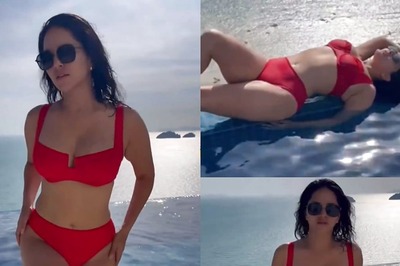
views
Common Types of Breasts
Archetypal Archetypal breasts are round and full with a small point at the nipple. This is the “standard” breast type according to bra manufacturers, and they use this type to model their designs. Best bras: Most bras since this breast type is a common model for bra manufacturers While this may be a common breast type, it isn’t the “normal” type, as all breasts are unique. Even those with breasts that fall under this category have variations that set them apart. Meet the wikiHow Experts Daniel Barrett, MD, is a board-certified plastic surgeon with over 6 years of experience and the owner of Barrett Plastic Surgery in Beverly Hills, California. Monica Morris is an ACE-certified personal trainer with over 15 years of experience. She started her own physical training practice and gained her ACE certification in 2017. Asif Pirani, MD, is a board-certified plastic surgeon and the founder of Toronto Plastic Surgery Center in Toronto, Canada.
Asymmetrical Asymmetrical breasts refer to any set of breasts that are two different sizes. It is estimated that over half of all women have some degree of breast asymmetry, and it’s common for a set of breasts to vary by a cup size or less. Many women have asymmetrical breasts in combination with any of the other breast types. Best bras: Bras with a higher apex, bras with removable inserts, spacer bras If your breasts have a larger amount of asymmetry, wearing a bra with removable pads is a great way to make them look more even. Having asymmetrical breasts is completely natural. Board-certified plastic surgeon Daniel Barrett, MD, explains, “If someone has breast asymmetry, it generally happens during the developmental phase. Some asymmetrical situations happen after breastfeeding, but generally speaking, people are born with it.”
Athletic Athletic breasts are wider and have more muscle and less tissue than other breasts. They’re smaller in size and typically don’t have much volume at the top, which can lead to cup gaping when wearing a bra. Best bras: Padded bras, plunge bras, wireless bras, bralettes, sports bras Choosing the right bra will help ensure you feel comfortable and confident. If you’re not sure you’ve been wearing the right size, get professionally fitted.
Bell shape Bell-shaped breasts are full at the bottom and narrow at the top, resembling the shape of a bell. Most bell-shaped breasts tend to be larger, so you may experience overflow if you wear a bra with minimal coverage. Best bras: Full coverage bras, balconette bras, push-up bras, underwire bras
Close set Close set breasts have no separation or a very small gap between them. They sit closer toward the center of your chest and create more distance between your breasts and your underarms. Close set breasts may be rounded or have a more athletic appearance. Best bras: Balconette bras, wireless bras, underwire bras, M-frame bras To determine if you have close set breasts, put two fingers between them. If your fingers touch both breasts, they’re likely close set.
Conical Conical breasts, sometimes known as tubular breasts, closely resemble the shape of a cone. The top of the breast slopes down, and the base is small and narrow. The nipples typically point outward and sometimes protrude. This shape is more common in smaller breasts than larger ones. Best bras: Wireless bras, bralettes, bras with molded cups, graduated padding bras, balconette bras
East West East West breasts are characterized by nipples that point outward in opposite directions. These breasts are typically round and wide-set and may have a lack of fullness at the top that makes it difficult to achieve cleavage with certain tops. Best bras: Front-closure bras, T-shirt bras, push-up bras, underwire bras
Relaxed Relaxed, or pendulous, breasts have looser breast tissue with nipples that point downward. They’re typically longer in shape and hang more than other breast types. This shape often occurs due to a loss of skin elasticity as a result of aging, weight fluctuation, pregnancy, or other hormonal changes. Best bras: Seamless T-shirt bras, underwire bras, plunge bras, balconette bras, padded bras There’s nothing wrong with having relaxed breasts, but you can help prevent early sagging by exercising your chest muscles, eating a healthy diet, and moisturizing your skin.
Round Round breasts are equally full at the top and bottom, giving them a round shape. They tend to have a consistent shape and uniform appearance, and they typically don’t need a lot of coverage or support. Best bras: Most bras, including T-shirt bras, demi bras, plunge bras, and unlined bras
Side set Side set, or wide set, breasts are farther apart with more space between them than other breast types. They’re typically fuller, with nipples that face forward or slightly outward. They’re similar to East West breasts. Best bras: Balconette bras, plunge bras, push-up bras, front-closure bras, bras with side support panels
Slender Slender breasts are narrow and long, with nipples that point downwards. They’re typically smaller in size and are slightly longer than they are wide. This shape is often associated with athletic body types and becomes more prevalent with age. Best bras: T-shirt bras, demi bras, push-up bras, balconette bras, wireless bras
Teardrop Teardrop breasts are round with a bottom that is slightly fuller than the top, resembling the shape of a teardrop. These breasts resemble both round and bell-shaped breasts. If you have this shape, you may experience cup gaping with full-coverage bras. Best bras: Balconette bras, push-up bras, plunge bras, demi bras
What determines breast shape?
Breast shape is mainly determined by genetics. Your genes determine the basic structure and appearance of your breasts, such as their density, tissue, and size. They aren’t the only thing that affects your breast shape, however. Other factors include the following: Weight: Fat makes up a large part of your breast tissue and density, so your breasts may change shape if you gain or lose weight. Exercise: “The development of your pectoralis major and minor will result in the appearance and illusion of a larger breast size,” says ACE-certified personal trainer Monica Morris. Strengthening your pecs will build the muscle behind your breast tissue, often making them look firmer or perkier. Age: As you age, your breasts will naturally begin to sag and may become longer and shift to face downward. Pregnancy and breastfeeding: During pregnancy and breastfeeding, your hormones can make your breasts swell and change the way fat and tissue are distributed throughout them.
Does breast shape change over time?
Yes, your breast shape can change over time. Your breasts may change in size, shape, firmness, and tissue composition at different points throughout your life, including puberty, pregnancy, breastfeeding, menopause, and aging in general. This is typically due to hormonal changes and is totally normal and expected. Some women begin noticing changes in their breasts in their 20s, while others may not see significant changes until their 40s. Some may have relatively stable breast shapes throughout their lives, while others experience fluctuations depending on their menstrual cycle, pregnancy, and weight changes. As you approach menopause, your estrogen levels drop, which causes the connective tissues in your breasts to become dehydrated and lose elasticity. This often causes breasts to begin to sag, which is totally normal.
See a doctor if you notice pain, lumps, or sudden changes. While it’s normal for breasts to change over time, sudden and unexplained changes could be signs of an underlying health condition, like breast cancer. See a doctor if you notice any of the following symptoms: Unexplained tenderness or soreness Unexplained redness or bruising Abnormal or bloody nipple discharge Lumps or swelling in the breast tissue A sudden change (ex: a raised nipple suddenly becoming retracted)
Nipple & Areola Variations
Areolae also come in unique shapes and sizes. Areolae are the darker areas that surround your nipples, and no two sets are the same. The average areola is 4 cm in diameter, but some are much smaller or much bigger. Your areolae may also change in size over time or during pregnancy or breastfeeding. Areolae also come in many different colors. People with darker skin typically have darker areolae than people with lighter skin, but this isn’t always the case. Your areolae can also come in different shapes. They may be uneven or lopsided rather than perfectly round circles. This is totally normal!
Nipples have many variations. Like the areolae and the breast itself, nipples come in many different shapes, sizes, colors, and more. Here are some common variations you might see in your own nipples: Bumpy: Bumpy nipples have prominent Montgomery glands, which are small bumps around the areolae. Everted: Everted nipples are erect and stand up even when they aren’t stimulated. Inverted: Inverted nipples retract inward rather than being erect, explains board-certified plastic surgeon Asif Pirani, MD. Flat: Flat nipples stay at the level of the areolae, though they may become erect when stimulated. Hairy: Many nipples have hair growing around them, and some have more hair than others. Protruding: Protruding nipples stand more erect than everted nipples, even without stimulation. Many women develop protruding nipples after breastfeeding and pregnancy, adds Dr. Pirani. Puffy: When nipples are puffy, both the nipple and areola form a raised mound. Supernumerary: Supernumerary means you have an extra nipple. Unilateral inverted: One nipple is inverted and the other is everted.
What is the typical breast shape?
There is no “normal” breast shape—they’re all unique! While there is the archetypal breast shape that bra manufacturers use to shape their designs, there is no single “ideal” or normal shape. Breasts come in a variety of shapes and sizes, and even those that are the same “type” have variations that make them unique.
Should I change the shape of my breasts?
Don’t feel pressured to change the shape of your breasts. All breast shapes and sizes are unique, so there’s nothing to be insecure about. However, if the size or shape of your breasts interferes with your daily life or if you’d feel more comfortable with a different shape, there’s nothing wrong with getting plastic surgery. Do whatever makes you feel most confident. The most common plastic surgery procedures are breast lifts, breast reductions, implants, and fat grafting. If you’re considering plastic surgery, talk to a plastic surgeon about which option is best for you. If you’re considering plastic surgery, Dr. Barrett stresses the importance of doing your research and finding a board-certified plastic surgeon who will help you get the results you want. “This is your body,” he says. “You don’t want to make any mistakes.” There are temporary ways to change your breasts’ appearance, too. Try wearing different types of bras and shirts to see which look you like the best.


















Comments
0 comment